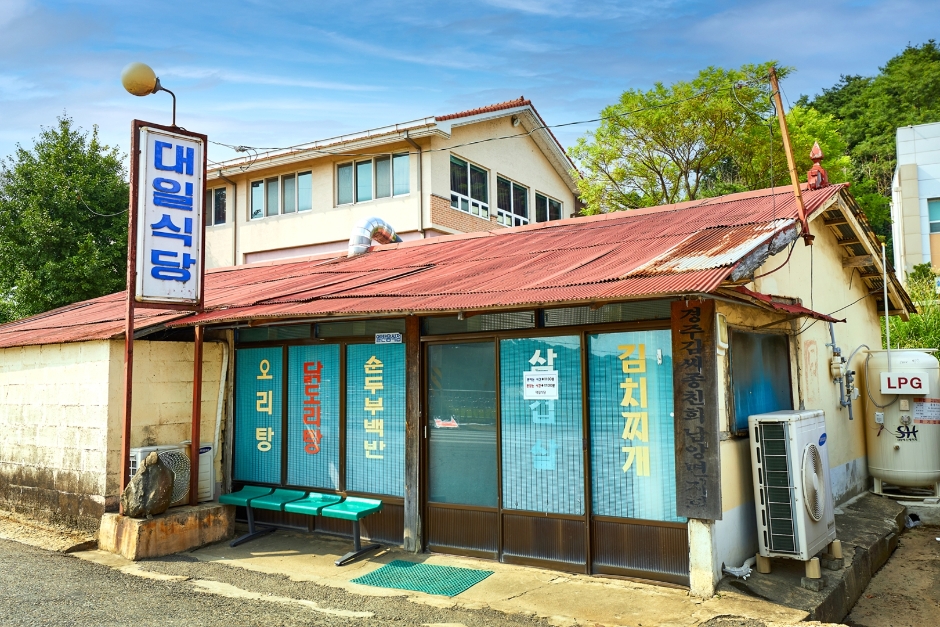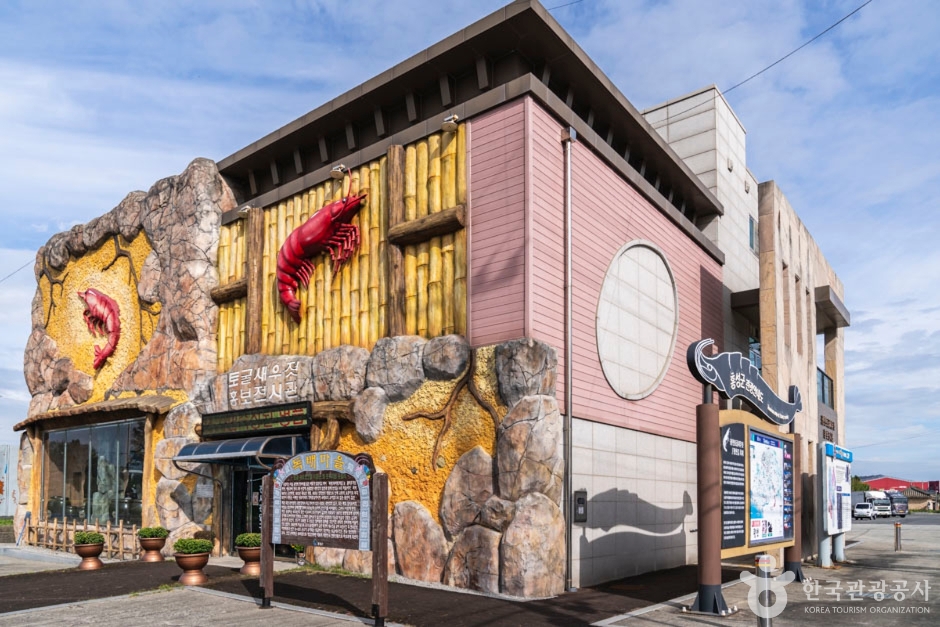Seokhwachon (Boryeong) (석화촌(보령))
8.6Km 2024-02-26
15 Bakgangsul-gil, Jupo-myeon, Boryeong-si, Chungcheongnam-do
041-932-9005
Seokhwachon is a traditional Korean restaurant converted from a rural house. It specializes in Korean dishes. The menu includes specialties such as hanbang ori baeksuk (whole duck soup with medicinal herbs), hanbang dak baeksuk (whole chicken soup with medicinal herbs), samgyetang (ginseng chicken soup), saengseon gui (grilled fish), and galchi jorim (braised cutlassfish). The restaurant offers a variety of dishes that are both hearty and refined, combining sincerity and homemade flavors. Boasting a location where mountains and sea coexist, Boryeong offers diverse ingredients, and it hosts the Boryeong Mud Festival annually in July.
Daeil Restaurant (대일식당)
9.8Km 2024-03-11
334 Guyong-gil, Namyang-myeon, Cheongyang-gun, Chungcheongnam-do
This eatery is celebrated as a true local dining spot, where the ambiance brings one back to a bygone era through its interior and exterior design. It’s a baekban (set menu) restaurant that offers a hearty spread of Korean side dishes, soup (or jjigae), and rice. The menu keeps it simple with three distinct jjigae options: soft bean curd jjigae, known for its delicate texture; a robust soybean paste jjigae, simmered with savory soybean paste; and a zesty kimchi jjigae, renowned for its spicy excellence. Jjigae, a staple in Korean cuisine, pairs perfectly with rice and is a common feature at the Korean dinner table. Here, diners are invited to savor the authentic flavors of Korean home cooking. Notably, this restaurant has earned accolades for its moderately seasoned dishes that avoid overuse of spices, ensuring the flavors are palatable without being overpowering. Be mindful that during peak hours, like weekday lunchtimes, there may be a wait or the restaurant may be sold out of certain items due to popularity.
Hongseong Jeongamsa Temple (정암사 (홍성))
10.6Km 2021-03-12
652, Oseo-gil, Hongseong-gun, Chungcheongnam-do
+82-41-641-0488
Jeongamsa Temple is a small rural temple situated halfway up Oseosan Mountain. There are few existing records that mention the temple’s beginning. Some suggest that it was built around AD 527 during the 5th year of Baekje King Seongwang’s reign, but there is little evidence to support this theory. The only reference alluding to a specific time is Yeojidoseo ("Detailed Survey of Korean Geography" published during the late Joseon dynasty). It states Jeongamsa Temple's location as on Oseosan Mountain, and Oseosan Mountain being surrounded by Hongsan Mountain and Baegwolsan Mountain and intersected by Hongju, Gyeolseong, and Boryeong. This indicates the temple was recognized in the mid-18th century and around the same time, Garamgo (a book about temples, published in the late 18th century) also states that Jeongamsa Temple is located approximately 11 kilometers to the east of Gyeolseonghyeon. It is still uncertain whether the temple referred to is Jeongamsa Temple on Oseosan Mountain.
Some foundation stones within the temple site measure 70-80 centimeters on each side. These stones indicate that the old Buddhist shrine of Jeongamsa Temple was laid out with five kan (Korean unit of measurement indicating the space between two pilars) at the front and three kan on the side. Future archaeological studies will help identify the true history of Jeongamsa Temple.
Gwangcheon Cave Salted Shrimp Complex (광천토굴새우젓단지)
12.9Km 2024-02-26
119, Gwangcheon-ro, Gwangcheon-eup, Hongseong-gun, Chungcheongnam-do
Gwangcheon Cave Salted Shrimp Complex is a collection of shops offering saeujeot (salted shrimp), a specialty of Gwangcheon. Gwangcheon’s proximity to the Yellow Sea makes it a famous place for jeotgal (salted seafood), particularly those made with shrimp. Gwangcheon’s saeujeot (salted shrimp) is stored and aged in a former mine cave tunnel, so it has great quality. There is even an exhibition hall dedicated to Gwangcheon cave salted shrimp. The Gwangcheon Cave Salted Shrimp & Dried Laver Festival is held in October.
Gwangcheon Cave Salted Shrimp Market (광천 토굴새우젓시장)
14.3Km 2024-02-26
8-20, Gwangcheon-ro 285beon-gil, Gwangcheon-eup, Hongseong-gun, Chungcheongnam-do
Gwangcheon Cave Salted Shrimp Market is a traditional market located in Gwangcheon, between Hongseong and Boryeong. Gwangcheon’s proximity to the Yellow Sea makes it a famous place for jeotgal (salted seafood), made using seafood and shrimp caught from the Yellow Sea, and laver seaweed. Gwangcheon’s saeujeot (salted shrimp) is stored and aged in a cave tunnel, so it has great quality. The market also offers agricultural goods, seafood, clothing, and sundry items.
Chungcheong Suyeongseong Fortress in Boryeong (보령 충청수영성)
14.8Km 2024-02-21
Chungcheongsuyeong-ro, Ocheon-myeon, Boryeong-si, Chungcheongnam-do
Chungcheong Suyeongseong Fortress in Boryeong is a stone fortress built by the Joseon dynasty (1392-1897) in the 16th century to defend against invasions through the Hwanghae Sea. It offers a picturesque view of the Hwanghae Sea and several islands. The entrance to the fortress, called Manghwamun Gate, showcases stone artistry with its polished granite arch. This site also has historical significance as a place where Catholic persecution occurred in the 19th century.
Kimgane Jeontong Sagol Sujebi (김가네 전통사골수제비)
14.9Km 2024-02-21
57 Seokseo 1-gil, Boryeong-si, Chungcheongnam-do
041-934-4706
Kimgane Jeontong Sagol Sujebi is a sujebi (hand-pulled dough soup) specialty restaurant near Daecheon Beach. With over 50 years of tradition, the restaurant is renowned for its deep-flavored broth. The menu includes sagol sujebi (beef bone soup with hand-pulled dough), dogani sujebi (hand-pulled dough soup with ox knee), and kimchi sujebi (hand-pulled dough soup with kimchi). Sujebi is made by kneading flour and tearing it by hand into wide strips, which are then boiled with various ingredients. The chewy texture of the noodles varies slightly depending on the ingredients added.
Ocheon Port (오천항)
14.9Km 2024-02-21
Soseong-ri, Ocheon-myeon, Boryeong-si, Chungcheongnam-do
Ocheon Port is located in the northern part of Boryeong-si, where the Hwanghae Sea and Gwangcheoncheon Stream meet. It was once an important regional administrative center during the Joseon dynasty (1392-1897). Today, the port still retains its function, and visitors can explore and purchase various seafood caught in the Hwanghae Sea at the market. Ocheon Port Ferry Terminal operates ferry services to nearby islands such as Woldo Island and Yukdo Island.
Daecheon Port (대천항)
15.3Km 2024-02-21
2245 Sinheuk-dong, Boryeong-si, Chungcheongnam-do
Daecheon Port serves as a pivotal point for maritime transportation and a base for fishing in Boryeong. At the fish market, visitors can explore and purchase various seafood caught in the Hwanghae Sea, including fish, blue crabs, and shrimp. The early morning auctions are also a sight to behold. The coastal passenger terminal operates ferries to islands near Boryeong, such as Sapsido Island.
Boryeong Mud Festival (보령머드축제)
15.4Km 2025-06-27
Sinheuk-dong, Boryeong-si, Chungcheongnam-do
+82-41-930-0891
Among the many festivals in Korea, the Boryeong Mud Festival attracts the highest number of international visitors. Held annually in summer, the festival is filled with people eager to enjoy various experiences using high-quality mud from the Boryeong coast. Festival programs include the Mud Slide, Mud Run, and Mud Bath, providing a diverse range of activities for visitors. People of all ages and all nationalities gather for a jolly old time of jumping, rolling, and sliding. You can paint your body with colored mud, give yourself a mud massage, and play in the mud to your heart’s content. Highlights include the Ocean Fireworks Fantasy Show, Mud Busking Performances, and the Poseidon Water Music Festival, all of which add to the romantic atmosphere of a summer seaside celebration.
◎ Mud
Mud refers to grimy and watery earth on tidal flats along coastlines. Mud is rich in natural minerals that prevent skin from aging and give it fresh vitality and elasticity.




 English
English
 한국어
한국어 日本語
日本語 中文(简体)
中文(简体) Deutsch
Deutsch Français
Français Español
Español Русский
Русский